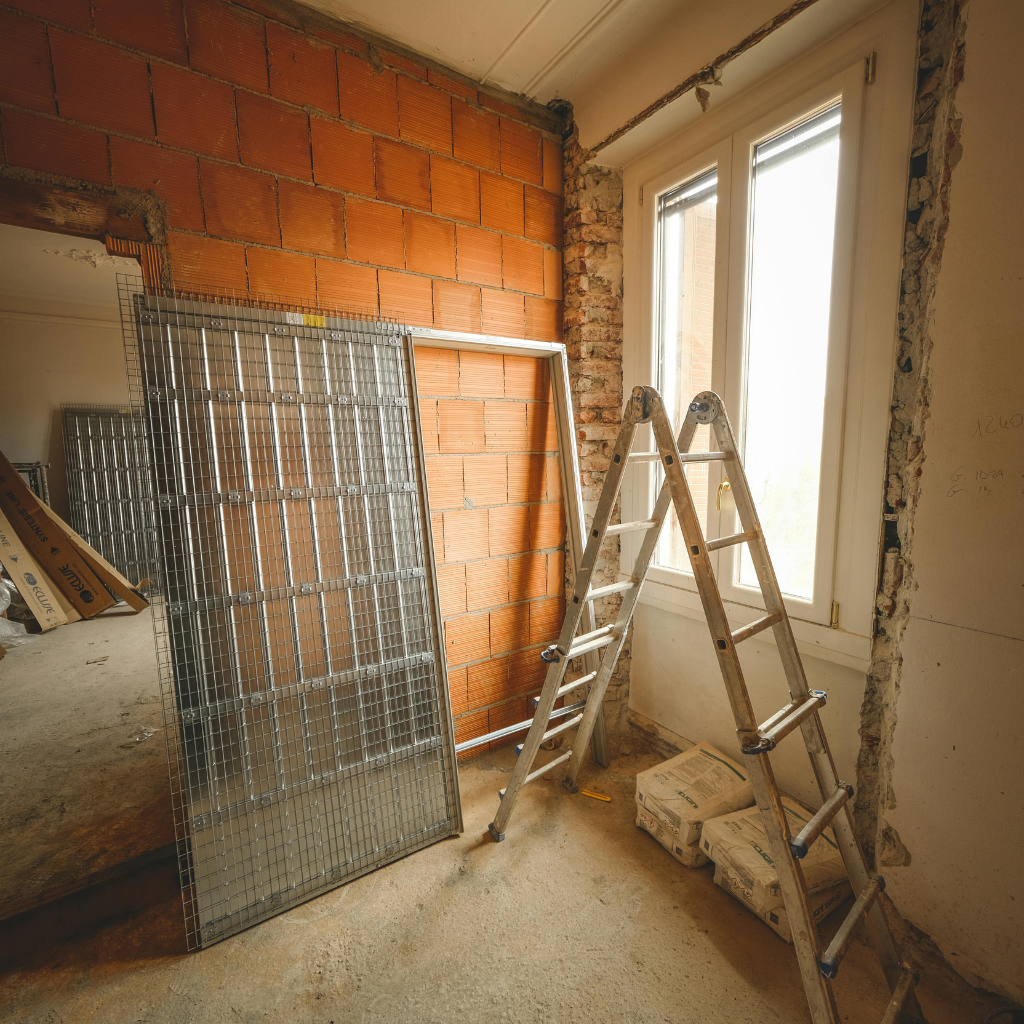Property refurbishment refers to the process of improving a building to enhance its functionality and aesthetic appeal, typically involving updates and enhancements. In contrast, renovation involves more extensive structural changes, often altering the building’s layout and function. Refurbishment can greatly increase a property’s market value by modernizing features while preserving its original charm. For further perspectives on elevating property through both words refurbishment and renovation, one might consider exploring the various types and benefits they offer.
What is Property Refurbishment?
While many may recognize the term, understanding property refurbishment requires acknowledging it as a worthwhile investment—a process focused on improving an existing property’s functionality, appearance, and market appeal.
Refurbishment can range from small updates like redecorating or replacing a dishwasher, to more extensive improvements such as modernizing electrical systems or updating an oven and kitchen setup. The scope of work varies depending on the condition, size, and intended use of the property.
Each project is tailored to suit the specific needs of the homeowner, with the goal of enhancing comfort, maintaining or increasing property value, and attracting potential buyers, especially in competitive markets.
At every stage, our team is prepared to manage your refurbishment project with care and expertise, ensuring it is completed safely, on time, and within budget.
Understanding the Property Refurbishment
While many may recognize the term, understanding property refurbishment entails recognizing it as a thorough process aimed at improving an existing property.
This refurbishment process varies widely depending on the condition of the property and the objectives of the property owner. Common types of property refurbishment might include simple updates like installing new decor or more extensive adjustments, such as redoing electrical systems.
Each refurbishment project is tailored to enhance the functionality and aesthetic appeal of the property, thereby potentially increasing its market value. Trust us to manage your refurbishment process efficiently, ensuring the best return on investment.
The benefits of property refurbishment are extensive, often leading to more efficient use of space and updated living conditions that align with modern standards.
The Difference Between Refurbishment and Renovation
Although refurbishment and renovation are terms often used interchangeably, they refer to distinct types of property improvements.
Property refurbishment typically involves updating or revitalizing an existing space, such as installing a new kitchen or repainting walls. It often aims to bring a property up to current standards without altering the fundamental design or structure.
On the other hand, a renovation project might involve more significant changes, like loft conversions or restructuring rooms, which can require adherence to building regulations. Consulting a trusted advisor team before acquiring investment properties can ensure the best decisions are made.
The difference between renovation and refurbishment lies in the scope and intent: refurbishments generally preserve and enhance existing features, while renovations can transform the layout or purpose of various types of property, often including common renovations that upgrade entire systems or structures.
Why Refurbish Your Property?
Property refurbishment involves updating and enhancing existing structures and systems to meet current standards and aesthetics. Unlike renovation, which often entails considerable structural changes, refurbishment can also focus on updates that greatly increase your property value without extensive reconstruction. Many prefer this route because it reduces stressful delays, especially when working under a tight period or budget.
Reasons to choose refurbishment include the desire to preserve the character of a property while improving functionality and efficiency. This can greatly boost the value of your property, making a refurbished property more appealing in the real estate market. Considerable value can be added by making strategic updates, such as replacing roof tiles, for example. Ultimately, refurbishment offers a cost-effective way to enhance a property’s value and appeal, making it a worthwhile investment for many.
You’ll find that even small upgrades, like fitting a modern dishwasher or replacing an oven, can make a big difference. With articles and blog posts available on our website, you can explore further ways to refresh your property.
Additionally, being aware of legal considerations and knowing how to act when it comes to permissions or restrictions is essential. Whether your property is located in a conservation area or not, following the right process will help you avoid notice issues or project delays.
If you’re planning a refurbishment, it’s important to stay committed to your goals, have the right team by your side, and take pride in the process. The reality is that with the right knowledge, you can safely improve your home beyond expectations, exceeding even your expectations by the time the project reaches its final date of completion.

How Does Property Refurbishment Impact Property Value?
Property refurbishment is an excellent way to boost both the aesthetic appeal and market value of a home or investment property. Whether you’re looking to refresh tired interiors or address structural issues, refurbishments—when executed to the highest standard—can significantly increase your property’s overall worth.
However, not all projects yield the same return. The type of refurbishment, the materials used, and adherence to building regulations all play crucial roles. Working with experienced contractors, staying committed to a clear vision, and understanding financing options such as refurbishment loans or bridging loans are also key.
Let’s explore how refurbishment contributes to value and what you need to consider along the way.
Enhancing the Value of Your Property
Refurbishing your property does more than just improve how it looks—it enhances functionality, modernises key areas like kitchens and bathrooms, and makes it more energy efficient. Whether you’re updating a small flat or undertaking a larger project like a loft conversion, a well-executed refurbishment can:
- Attract Buyers or Tenants: A visually appealing home with updated interior finishes, new flooring, or a converted kitchen can significantly improve buyer interest rates.
- Increase Comfort: Enhanced insulation, double-glazed windows, and energy-efficient systems improve daily life and reduce long-term costs.
- Add Living Space: Projects such as loft or garage conversions create additional living space, which is especially desirable for growing families or landlords seeking better rental yields.
Factors Influencing Property Value Increase
While various factors contribute to the increase in property value, refurbishment plays a pivotal role by directly enhancing both the aesthetic and functional aspects of a building. The renovation process, especially in commercial properties, can lead to substantial increases in a property’s value. It involves the key decision to ensure a property meets building control standards, which can further elevate the value of your home or business space.
| Type of Refurbishment | Expected Cost | Potential Value Increase |
| Structural | High | High |
| Energy Efficiency | Medium | Moderate to High |
| Compliance Upgrades | Variable | High |
Investing wisely in property maintenance and choosing the right type of refurbishment can balance the costs of refurbishment with significant value gains.
Refurbishment vs Renovation: Which Adds More Value to Your Property?
Understanding the distinctions between refurbishment and renovation is essential for property owners aiming to maximize their investment.
Property refurbishment typically focuses on restoration and minor updates, potentially increasing the property’s value by enhancing its appeal without extensive structural changes.
In contrast, renovation involves more significant transformations that can drastically alter the property and usually require adherence to planning and building regulations.
Here are key considerations to determine which adds more value:
- Scope of Work: Renovation may involve structural changes, while refurbishment usually updates the existing layout.
- Investment Cost: Refurbishment often costs less than complete renovations.
- Market Demand: In some markets, the sheer aesthetic improvement from refurbishment may be the better option for a property to sell quickly.
- Regulatory Concerns: Renovations might lead to more complications with local codes, impacting both timeline and budget.
Do You Need Planning Permission for a Renovation Project?
When commencing a property renovation, determining whether planning permission is required is one of the most important early tasks. It’s not simply about getting started—it’s about setting your project up for success with the right knowledge and legal footing.
This period of preparation involves understanding building regulation requirements and broader legal considerations tied to property refurbishment. Ignoring these steps can be stressful, leading to delays, financial setbacks, or worse, legal consequences.
When Planning Permission is Required
Whether or not you need planning permission depends heavily on the scope, location, and type of work you’re undertaking. Local councils enforce specific guidelines that must be followed. Typically, permission becomes necessary in the following circumstances:
- Structural Changes: Altering load-bearing elements (like knocking down internal walls or adding new rooms) usually requires approval to ensure safety and compliance.
- New Windows or Doors: Installing or altering windows, particularly double-glazed units, might need permission, especially if your property is in a conservation area.
- Extensions or Reductions: Any change to the footprint or height of the property must be reviewed by your local authority.
- Historic or Listed Buildings: If your home is heritage-listed, even minor changes may require specialist consent to preserve its historical character.
These permissions act as safeguards for the structural integrity, energy efficiency, and aesthetic standards of UK properties.
Understanding Building Regulation Requirements
Beyond planning permission, property refurbishment often necessitates compliance with building regulations, which serve as a separate set of standards guaranteeing safety, energy efficiency, and accessibility.
These building codes and regulations are vital regardless of the type of home renovation done, whether it involves significant structural changes or minor aesthetic updates.
For any refurbishment and renovation project, it is essential to ascertain that the property meets current requirements, particularly in areas like building, plumbing, and electrical services.
Differences between refurbishment work and renovation often lie in the extent of work. Still, both need to take into account these regulations to guarantee the state of the property remains safe and compliant.
Understanding these guidelines helps in planning permission and building processes, making certain renovations are legally and functionally sound.
Legal Considerations for Property Refurbishment and Renovation
While commencing a property refurbishment or renovation project, one of the primary legal factors is determining whether planning permission is required.
Property refurbishment is the process of updating or improving a building, often to address maintenance needs or enhance value. Here are some key points to examine:
- Extent of Changes: Minor modifications, often called light refurbishment, might not need permission, but major alterations typically do.
- Local Regulations: Property developers must check local council regulations, as they vary widely.
- Historic Properties: Special permissions are usually required for house refurbishment in heritage-listed areas.
- Refurbishment Loans: Financial institutions might require approved planning permissions before granting refurbishment loans for property purchases.
Individuals choose to refurbish their rental properties or fix them for various reasons, which impacts the legal prerequisites involved. Objectives, market opportunities, and finances should be considered when planning refurbishment projects.
What Are the Types of Property Refurbishment?
Property refurbishment encompasses a variety of types, each catering to different needs and outcomes.
A property refurbishment project can differ significantly in complexity, depending on the scale, location, and objectives. Property owners need to identify the right type of refurbishment that aligns with their objectives, whether enhancing functionality, style, daily life, aesthetics, or overall value.
Understanding the specific benefits of each refurbishment type can guide homeowners in making informed decisions that maximize their investment and reduce unexpected expenses over the long run.
Exploring Different Types of Refurbishment
Exploring the different types of property refurbishment reveals a variety of approaches, each suited to specific goals and contexts.
Property owners need to know about refurbishment options to make informed decisions, particularly when partnering with builders, decorators, or other certified professionals.
Here are four main types:
- Refurbishment: This involves cosmetic updates such as painting, decorating, and updating fixtures to make the property more desirable and aesthetically pleasing.
- Structural Refurbishment: Addresses the core structural alterations of an old property, including walls, roofs, and foundations, and ensures it is structurally sound. These projects often involve plumbers, electricians, or even rebuilding parts of the structure to create a safer and more practical space.
- Upgrade Refurbishment: Focuses on upgrading kitchens, bathrooms, heating, plumbing, and electrical systems to meet modern standards. This can include new installations, new flooring, and lighting to meet clients’ expectations.
- Restoration Refurbishment: Aims to restore historical properties in the UK to their original condition, which may vary depending on age, listed status, and location.
Choosing the Right Type of Refurbishment for Your Needs
Having outlined the main types of property refurbishment, property owners need to select the approach that best aligns with their specific needs and objectives.
Choosing the right refurbishment strategy can be vital, especially since real estate investing carries substantial financial risks and requires commitment and a clear understanding of your goals.
Whether renovating a mid-terrace bedroom or deciding between refurbishment and renovation for a larger estate, understanding the key differences is essential. This is where consulting with an estate agent or industry professional proves invaluable.
Each option in the refurbishment and renovation spectrum of property improvement has its own set of benefits and potential financial pitfalls. In larger projects, delays, permits, and structural issues must be considered.
Thoroughly evaluating the refurbishment process helps mitigate risks and ensure that the investment optimizes value and functionality according to the priorities of the owner, tenants, finances, and the trusted advisor.
Understanding the Benefits of Different Property Refurbishment Types
As we explore the various types of property refurbishment, fix and flip projects, and loft conversions, it becomes clear that each category serves distinct purposes and offers unique advantages.
These enhancements not only improve functionality but also elevate the property’s value through exceptional service and design. Refurbishment finance and even bridging loans can help fund these upgrades, especially in complex or time-sensitive cases.
- Refurbishment: Involves updating fittings, light fixtures, painting walls, and installing double-glazed windows to improve aesthetic appeal and energy efficiency.
- Structural Refurbishment: Focuses on major repairs like fixing doors, repairing damage, or replacing roof tiles—essential for long-term health, safety, and comfort.
- Performance Refurbishment: Enhances the building’s comfort and energy rating by upgrading insulation, heating systems, or ventilation—a popular choice for landlords or those planning to rent the property.
- Outdoor Refurbishment: Revitalizes exterior space, such as gardens or balconies, and may involve new kitchen decking, paving, or fencing. These additions can significantly increase curb appeal and sales potential.
How to Manage Refurbishment Costs Effectively?
Managing refurbishment costs effectively begins with a precise estimation of expenses.
Whether it’s a kitchen remodel or a full property refurbishment project, property owners should explore financing solutions like refurbishment finance, refinance, or bridging loans to make such commitments financially viable.
Focusing on refurbishments that maximize overall value ensures both the utility and financial viability of the investment.
Estimating Refurbishment Costs
Estimating refurbishment costs accurately is vital for managing a property renovation budget effectively.
Whether the project involves acquiring investment property, setting up office space, or revitalizing a tired residential unit, understanding the financial implications is critical.
To manage costs effectively:
- Assessment of Needs: Identify what repairs, structural issues, or upgrades need to be addressed.
- Detailed Quotations: Obtain multiple quotes from builders to ensure competitive pricing and match clients’ expectations.
- Contingency Planning: Allocate 10–20% for unexpected expenses, especially in older properties where issues may arise.
- Regular Monitoring: Track project stays on schedule and within budget. This is particularly important if the property fails to sell or is key to building wealth through rental properties.
Maximizing Property Value with Smart Refurbishments
To maximize property value through refurbishments, it is vital to prioritize cost-effective strategies that enhance both interior appeal and practical functionality.
Here are key steps to manage costs and boost value:
- Plan Thoroughly: For a 3-bedroom mid-terrace, focus on essentials like a new kitchen, modern flooring, or a loft conversion to add additional living space.
- Budget Wisely: Allocate funds strategically. Don’t overspend on expensive features unless they are reflected in future sale or rental value.
- Choose Durable Materials: Select fittings and finishes that are built to last and offer comfort for occupants, which is especially important for landlords and tenants alike.
- Monitor Progress: Keep an eye on the schedule to prevent delays and ensure your contract is met with professionalism and excellence. Communication with workers is vital to keep everything on track.
Conclusion
In summary, property refurbishment enhances both the aesthetics and functionality of a building, potentially increasing its market value. Whether just updating the decor, installing a single room, or undertaking a complete overhaul, careful planning and budget management are essential. Understanding the need for planning permissions can guarantee legal compliance and smooth execution. By considering various refurbishment types and strategies, property owners can make informed decisions that align with their goals and financial constraints, ultimately achieving a successful refurbishment project. For those wondering what is house refurbishment, it refers to the process of improving and updating a property to enhance its appearance, performance, or value.















